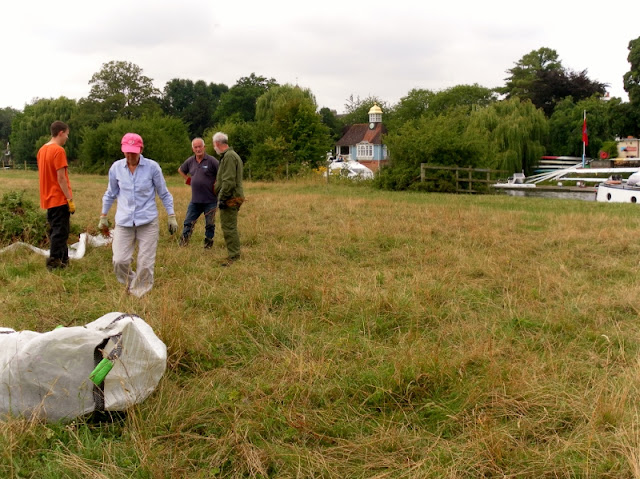By the Session Leader:
The appointed task was not one normally greeted with enthusiasm by
Green-Gymmers. Memories of recalcitrant docks
and thistles, which we were invited to pull (fat chance of that!) at a nearby
site very late in the season one year had not faded completely.
Our venue
this time was also a meadow beside the river Thames, a little further
downstream and on the opposite bank. As
is typical of the local culture, it is known quite simply as ‘Riverside Meadows’. It lies off the junction of the main street
of Crowmarsh village (‘The Street’ – that really is the official name) with the
bridleway which runs parallel to the river along the floodplain (‘Watery Lane’).
Within
Riverside Meadows, the specific work-site was ‘Field C’:
 |
| Field C viewed from the west side. In the background: hedge-line planted by a previous WGG party; tree-line running alongside Watery Lane; in the distance, Crowmarsh Hill |
The task: as before, to clear the
pasture-land of weeds which are of concern to farmers. On this occasion, some of the plants were
still in flower; and our instructions were simply to de-head (‘top’) and remove
the cuttings to a place where they can do no harm to the agricultural purpose
of the land.
This was the main species we were to prevent
from seeding:
 |
| Curled/Curly Dock (Rumex crispus) – building in the background is a boat club |
We also went for various varieties of
thistles, as we came across them:
Nettles (of which there were a few) were
largely spared on this occasion.
Not our
favourite job then. But the aim of WGG is
good exercise, so the group was happy to get going. As you can see, there were plenty of both
dock and thistle to go after. Volunteers
had different methods of making the final approach: bowing or genuflecting.
A group of
friendly cows came over to help, probably because they thought the buckets we
were using to collect the cut seed-heads might contain food. They were described to us as “Holsteins”, 1-year-old.
[I’d
have called those cattle ‘Friesians’: used for dairy in northern Europe (which is
where they originate) and GB; mixed-use elsewhere in the world. ‘Holstein’ is what the breed is named in the
USA. Kept making me think of beer (Holsten
Pils). Mmm… beer – Ed.]
Besides the
buckets a new tarpaulin, requested at our recent AGM, was trialled:
 |
| “It’s bigger than I thought!” |
 |
| First use – that’s the thistle, now an ex-thistle, which you saw earlier in the photo near the top of the page |
The tarp had
the advantage of taking a big load of the vegetation, here arranged, as one
member put it, “as a sculpture suitable for the Tate Modern”:
This became
quite heavy to pull, but, art or not, it was hauled away for destruction:
The trouble
with a new tarpaulin is that no one wants to risk tearing it on the barbed wire. Eventually, when the pile had been
reduced to a manageable weight, the remainder was tipped over, by which time
quite an audience of Green-Gymmers had gathered to watch
At tea break,
the cows came over in force. One, bolder
than the others, came round to explore the landie:
Chiefly,
however, they were fascinated by this new plaything …
although
they decided it did not taste as good as grass:
Equally
methodically, we Green-Gymmers worked our way across the field, clearing as far as the footpath
which runs directly beside the river.
Now we had a closer view of boats and boathouses, including Wallingford
Rowing Club’s, which we had first seen in the distance at the start of the
session:
Several
walkers came over to find out why on earth we were pulling docks and thistles,
thinking that the cows would eat them.
Cows are not the brightest of farm animals, but they know what they
don’t like. [Smarter than sheep, though; still not the brightest of stars – Ed.]
The weeds at
Riverside were easy to deal with – indeed some proved quite amenable to being pulled
– and several members actually said at the end that it had been a very
enjoyable day’s exercise. Field C is
big, but over the morning we had succeeded in clearing a good half of it.




















